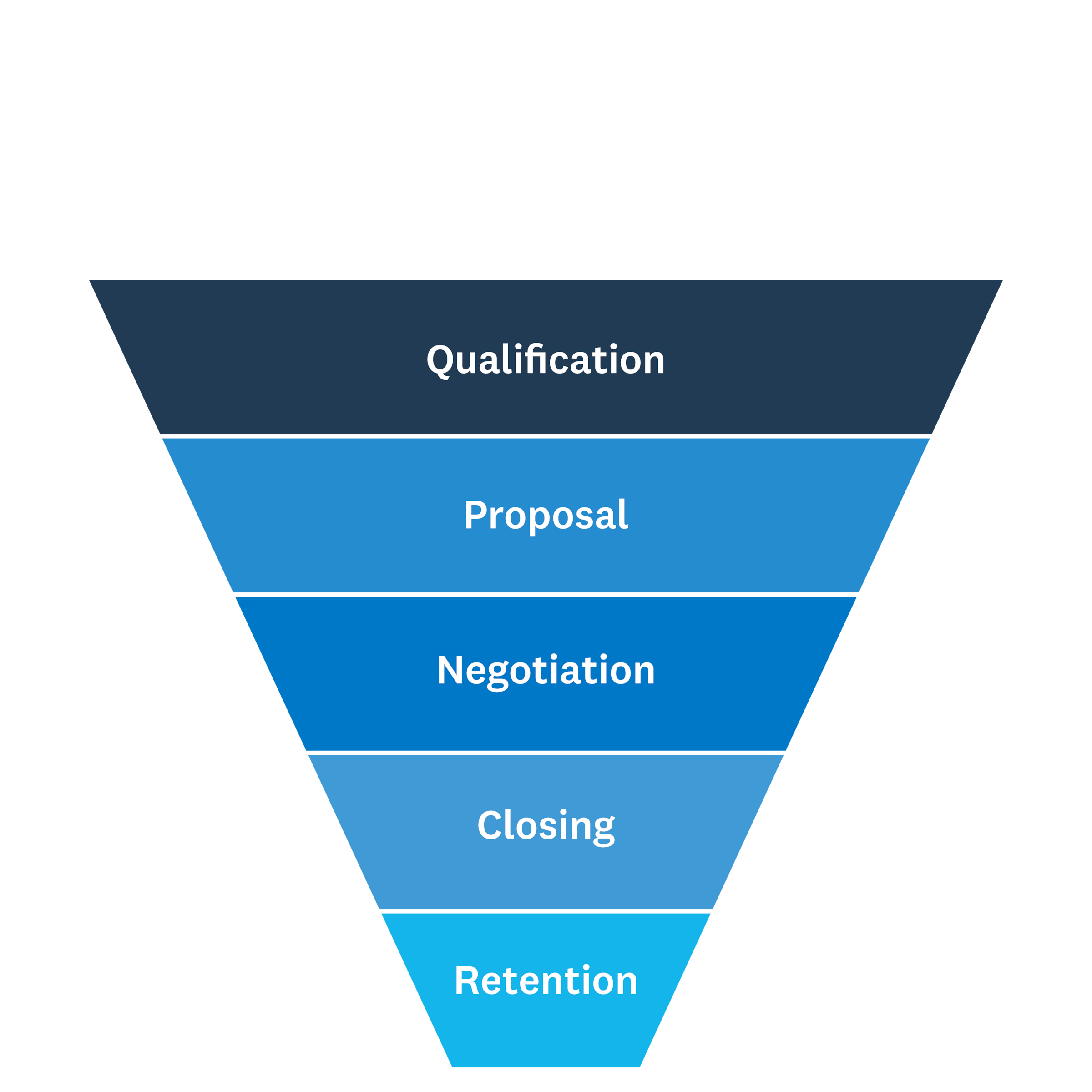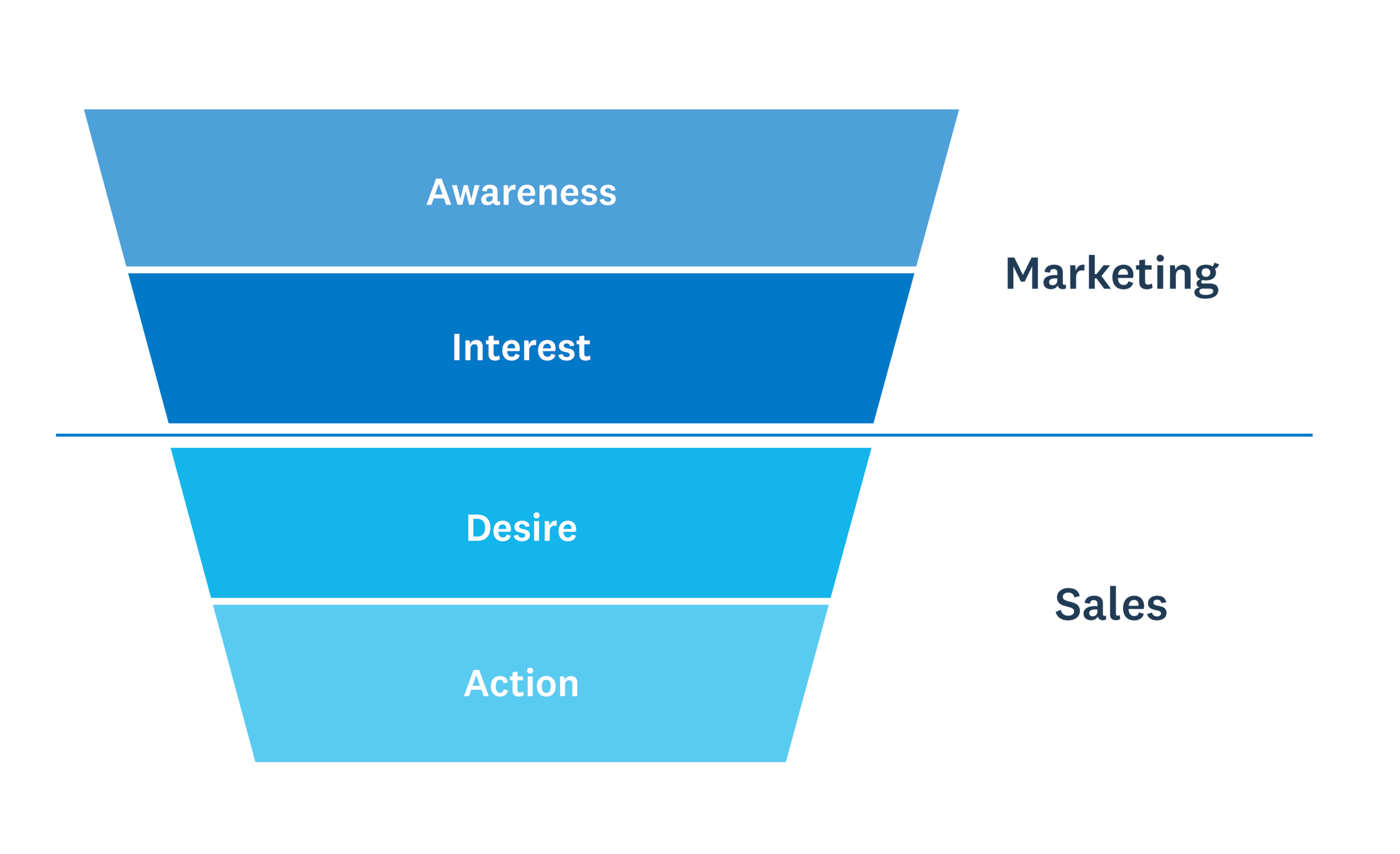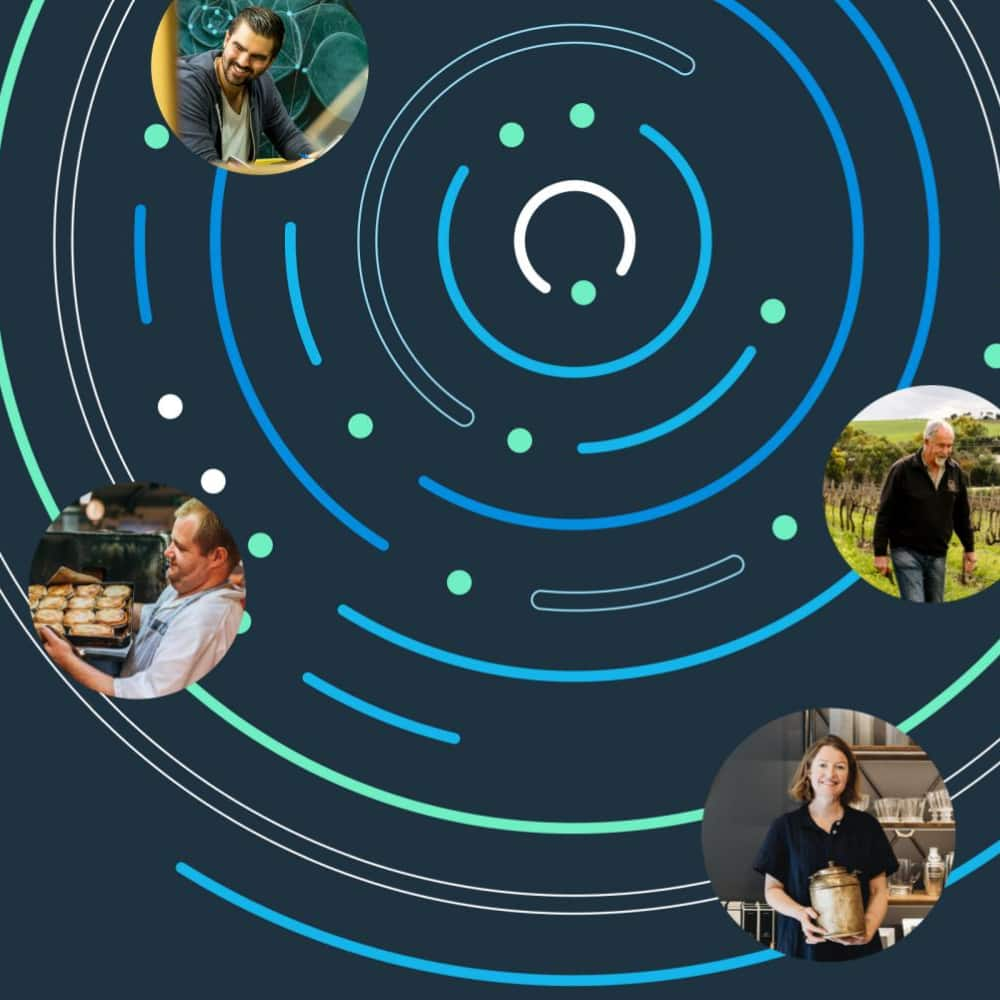What is a sales funnel (and why your business needs one)
Learn how sales funnels work, their key benefits, and practical tips to optimize yours for business growth.

What is a sales funnel?
A sales funnel is a step-by-step model that represents the journey a potential customer takes before making a purchase.
It guides prospects from the top of the funnel (TOFU), where they first become aware of a brand. As leads move through each stage, the funnel narrows – some drop off due to lack of interest, budget constraints, or alternative solutions. By the bottom of the funnel (BOFU), only the most qualified leads remain, ready to make a purchase decision.
For example, imagine an online store selling speciality coffee beans. A customer might discover the brand through Instagram, then browse the website, join the email list for a 10% discount, add a bag of beans to their cart, and finally complete the purchase.
Also known as a business growth funnel, conversion funnel, and purchase funnel, each stage reflects increasing commitment, and understanding this process helps businesses nurture prospects more effectively and improve conversion rates.
What are the sales funnel stages?
Before your prospective customer even reaches the sales funnel, you marketing needs to grab their attention. But once you’ve piqued their interest, they’ll hopefully start engaging with your business – by jumping on your website, signing up to a newsletter, or asking for more info.
Now they’ve entered the sales funnel, so you now need to which typically consists of five key stages:
1. Qualification – Identify the best-fit prospects based on their needs, budget, and timeframe.
2. Proposal – Present your product or service to qualified prospects, demonstrating its value.
3. Negotiation – Address any remaining objections and discuss terms, pricing, or contract details.
4. Closing – Finalize the sale by securing an agreement, processing payments, and completing the transaction.
5. Retention – Ensure customer satisfaction to encourage repeat business and long-term loyalty.
What are the benefits to using a sales funnel?

Implementing an effective sales funnel process delivers plenty of advantages for SMBs, helping them compete more effectively in their markets.
Better understand customer behavior
Analyzing how prospects move through your sales funnel reveals which customer segments are most likely to convert.
By identifying patterns in successful conversions, you can recognize ideal customers earlier and allocate more resources to the most promising leads. Examining each stage of the lead conversion process also provides insight into factors driving purchasing decisions, helping you tailor your messaging to better connect with potential customers and increase conversions.
For example, customer behavior data might flag that high-converting leads come from specific industries. Armed with this knowledge, you should prioritize similar prospects and also put more resources towards customer acquisition in these industries. Focusing on leads with the highest probability of conversion saves you time and effort, too.
Additionally, consumer behavior varies across regions, and understanding these local trends lets you adapt your sales funnel strategies to maximize conversions in your market.
Forecast sales more accurately
Your sales funnel is a valuable source of data that can improve forecasting and enhance sales predictions. By analyzing conversion rates at each stage of the process, you can accurately estimate future sales volumes.
For example, if a large sample of data shows that 20% of qualified leads request a callback and 40% of those convert into paying customers, you can project sales based on your pool of qualified leads. Additionally, this insight helps you determine how much you can invest in lead acquisition while still generating positive returns.
Drive business growth
A sales funnel supports data-driven growth by providing valuable performance insights at every stage. Creating an effective sales funnel requires tracking key metrics to identify bottlenecks, then taking targeted action to fix them.
For example, if sales funnel data shows that 40% of people who download your brochure request a demo, but only 3% of those demos lead to a price quote, you've found a probable weak point in your sales funnel. Refining your demo presentation could significantly increase the prospects reaching the next stage. Consistently optimizing your sales funnel, especially at critical points like this, compounds into major gains in overall conversions.
The retention stage is another major growth opportunity that many businesses overlook. Tracking metrics like customer lifetime value, repeat purchase rate, and churn helps develop strategies for nurturing prospects over longer time frames. Creating a separate sales funnel for upselling active customers can be highly effective – selling to existing buyers is typically far more cost-efficient than acquiring new ones.
For example, in 2024 small business sales rose an average of 0.8% year-over-year in the three months to September, following a 0.1% fall in the June quarter (revised up from the 0.9% y/y decline initially reported. Learn more with XSBI data on customer behaviour trends.
Sales funnel examples
While every business tailors its sales funnel to its audience, the core structure remains the same.
Here are three examples of how different business models apply the sales funnel stages to optimize results.
eCommerce sales funnel
The eCommerce sales funnel aims to move customers from product discovery to purchase swiftly and with minimal friction.
1. Attract – Ads, SEO, social media.
2. Engage – Product page, images, and reviews.
3. Capture – Discounts or freebies for email sign-ups.
4. Nurture – Retargeting ads, abandoned cart emails.
5. Convert – Seamless checkout experience.
6. Retain – Personalized product recommendations.
B2B sales funnel
The B2B sales funnel focuses on building trust and demonstrating expertise to drive high-value conversions.
1. Attract – Content marketing, networking, referrals.
2. Engage – Webinars, case studies, whitepapers.
3. Capture – Gated content, consultation offers.
4. Nurture – Follow up emails, demos, personalized outreach.
5. Convert – Proposals and negotiations.
6. Retain – Ongoing support, upsells.
SaaS sales funnel
The SaaS sales funnel converts prospects into users through free trials or demos, then retains them with ongoing value.
1. Attract – SEO, PPC, content marketing.
2. Engage – Landing pages, videos, case studies.
3. Capture – Free trials, demos, limited-access plans.
4. Nurture – Onboarding emails, tutorials, in-app prompts.
5. Convert – Upgrades for premium features, time-limited offers.
6. Retain – Strong support, regular updates, loyalty incentives.
Sales funnel vs. marketing funnel
While both the sales funnel and marketing funnel guide customers toward a purchase, they focus on different sales process stages and follow distinct strategies.
- Marketing Funnel (Awareness/interest stage)
- Sales Funnel (Desire/action stage)

Why aligning marketing and sales matters
When sales and marketing work together, they create a seamless customer experience and drive better results:
- Smooth handoff: Qualified leads from marketing help sales focus on high-potential prospects.
- Consistent messaging: Using the same language ensures clear, cohesive communication.
- Better insights: Shared data gives a complete view of the customer journey, allowing both teams to optimize strategies.
Aligning your marketing and sales teams is well worth it – companies with aligned marketing and sales teams are 67% more effective at closing deals.
How to create a sales funnel
Creating an effective lead generation funnel requires careful planning across each stage to smoothly guide prospects toward conversion.
1. Qualify your leads
Evaluate each lead’s needs, budget, and decision-making authority to determine if they’re a good fit. Understanding demographics, pain points, and purchasing behaviors helps gauge their probability of converting and tailor your approach for the rest of the funnel accordingly.
External factors also matter – leads in thriving industries or regions are more valuable than those in struggling markets. Focus your marketing efforts where the potential is highest to drive more conversions.
Learn more about market research and strategies tailored for SMBs.
2. Propose your product or service
Present your product or service to qualified leads through sales calls, demonstrations, or formal proposals.
A personalized approach that directly addresses their pain points and clearly highlights your UVP works best.
3. Negotiate the details
During this stage, discuss terms, address objections, and negotiate pricing or contract details. A personalized approach to overcoming each prospect’s specific concerns is key to moving them toward closing the deal.
Flexibility is crucial – timing and urgency play a major role in decision-making. Economic factors like interest rates and inflation can also influence a prospect’s willingness to commit, so being adaptable to shifting market conditions is essential.
4. Close the sale
Finalizing the sale involves easing last-minute friction and making it as easy as possible for the prospect to say “yes.” A seamless checkout or contract process with flexible payment options helps close the deal efficiently.
Offering incentives like exclusive discounts or free upgrades can provide the final push needed to secure the sale.
5. Retain your customers
Strong post-sale support fosters customer satisfaction and can turn a one-time buyer into a long-term customer. Initiatives like loyalty programs demonstrate that you value existing customers, encouraging repeat business – and potentially upsells.
Tips for optimising your business’ sales funnel
Here are some key strategies for sales funnel optimization that small businesses can use to maximize conversions.
Strengthen lead qualification
Ensure your leads are the right fit for your business by continuously refining your targeting criteria.
Use CRM tools to track engagement and prioritize the most promising leads.
Use data to refine and scale your sales funnel
Track conversion metrics at each stage along the conversion path to identify drop-off points and areas for improvement. Use data-driven insights from tools like Google Analytics to better understand user behavior.
Funnel optimization strategies include:
- Eliminating bottlenecks by simplifying forms and reducing user friction.
- Segmenting your audience to tailor sales funnel strategies.
- Running A/B tests on email subject lines, landing page copy, and other key elements to maximize performance.
Enhance the post-sale experience
Create a structured onboarding process that sets customers up for success from day one.
Leverage automation to deliver timely email sequences and value-driven follow-ups – case studies, product demos, and personalized tips – to help customers get more from their purchase and feel satisfied.
Understand and map customer journeys
Customer journey mapping is the process of visualizing and analyzing the steps a customer takes from initial awareness to conversion and beyond. There are typically four core customer journey stages:
1. Awareness – A potential customer learns about your business through social media, search engines, or word of mouth.
2. Interest – They engage with you by clicking an ad, visiting your website, or signing up for your email list.
3. Desire – They consider purchasing by reading reviews, requesting a demo, or inquiring about your product or service.
4. Action – They commit to the purchase by negotiating terms, signing a contract, or making a payment.
Mapping customer journeys helps you identify drop-off points, tailor your message, and ignite conversions. When you understand how prospects move through each stage, you can optimise your sales funnel for maximum results.
Gain deeper insights for your sales funnel with Xero
Use data-driven insights to refine your sales and marketing strategies, boost conversions, and make smarter decisions. Xero Small Business Insights offers valuable trends and analysis to help you stay informed and adapt to changing market conditions.
Small business continues to adapt and grow*
Read the full report for Xero's small business insights focusing on several core performance metrics, including sales growth, jobs, time to be paid, and late payments.
AU sales:+3.7%*
Small business sales grew an average 3.7% y/y in the three months to September. Published 31 October 2024.

Disclaimer
Xero does not provide accounting, tax, business or legal advice. This guide has been provided for information purposes only. You should consult your own professional advisors for advice directly relating to your business or before taking action in relation to any of the content provided.
Start using Xero for free
Access Xero features for 30 days, then decide which plan best suits your business.